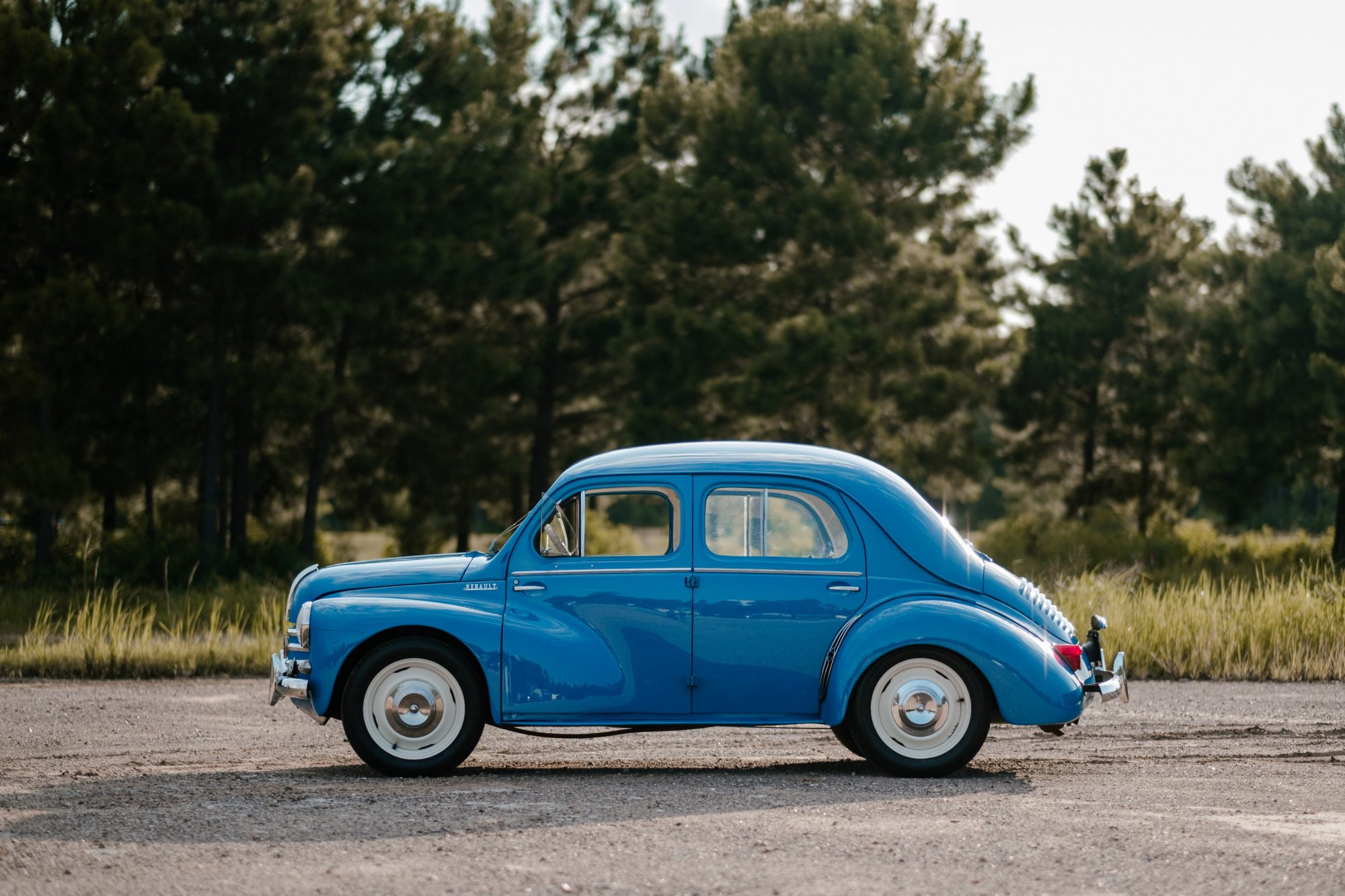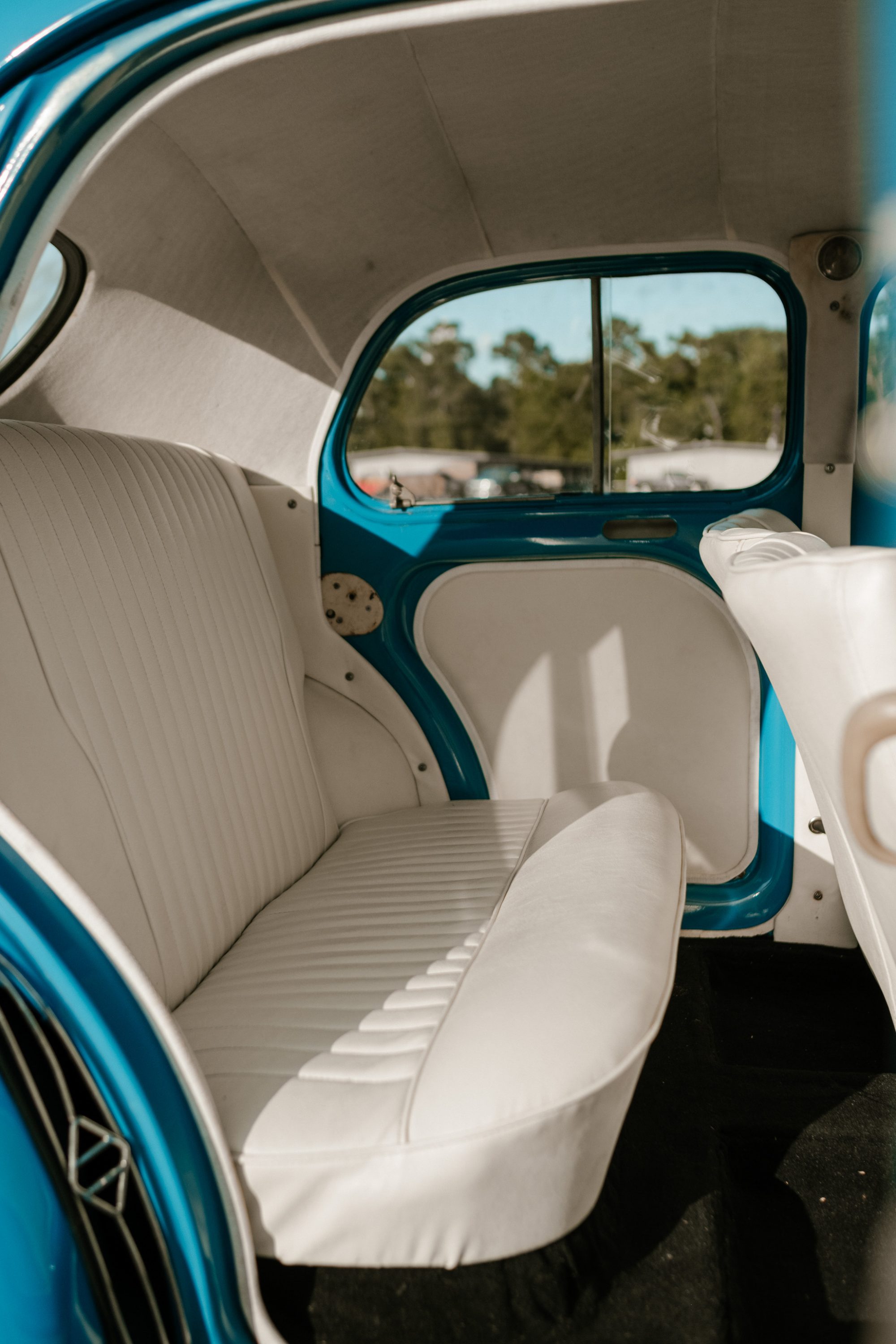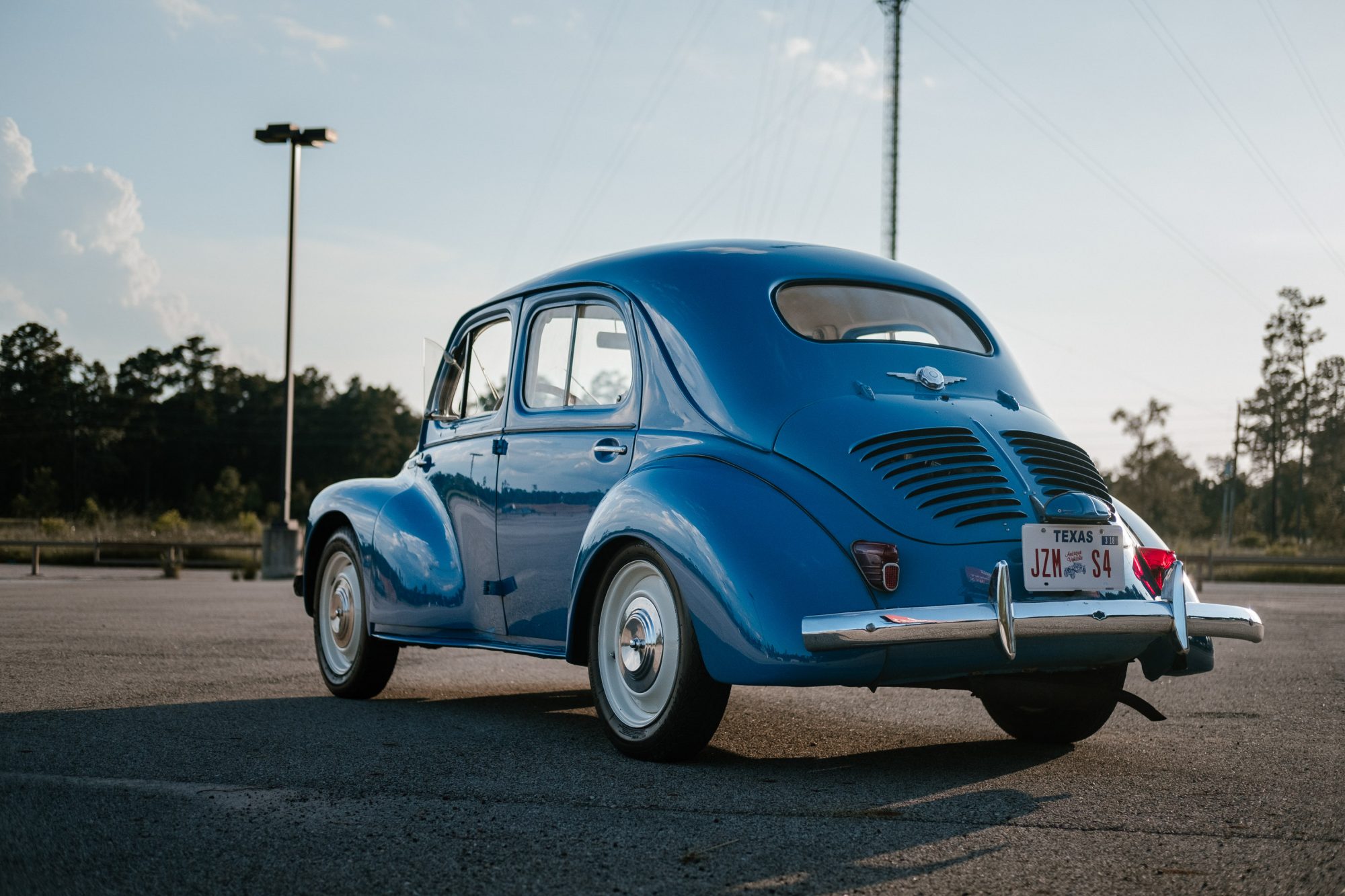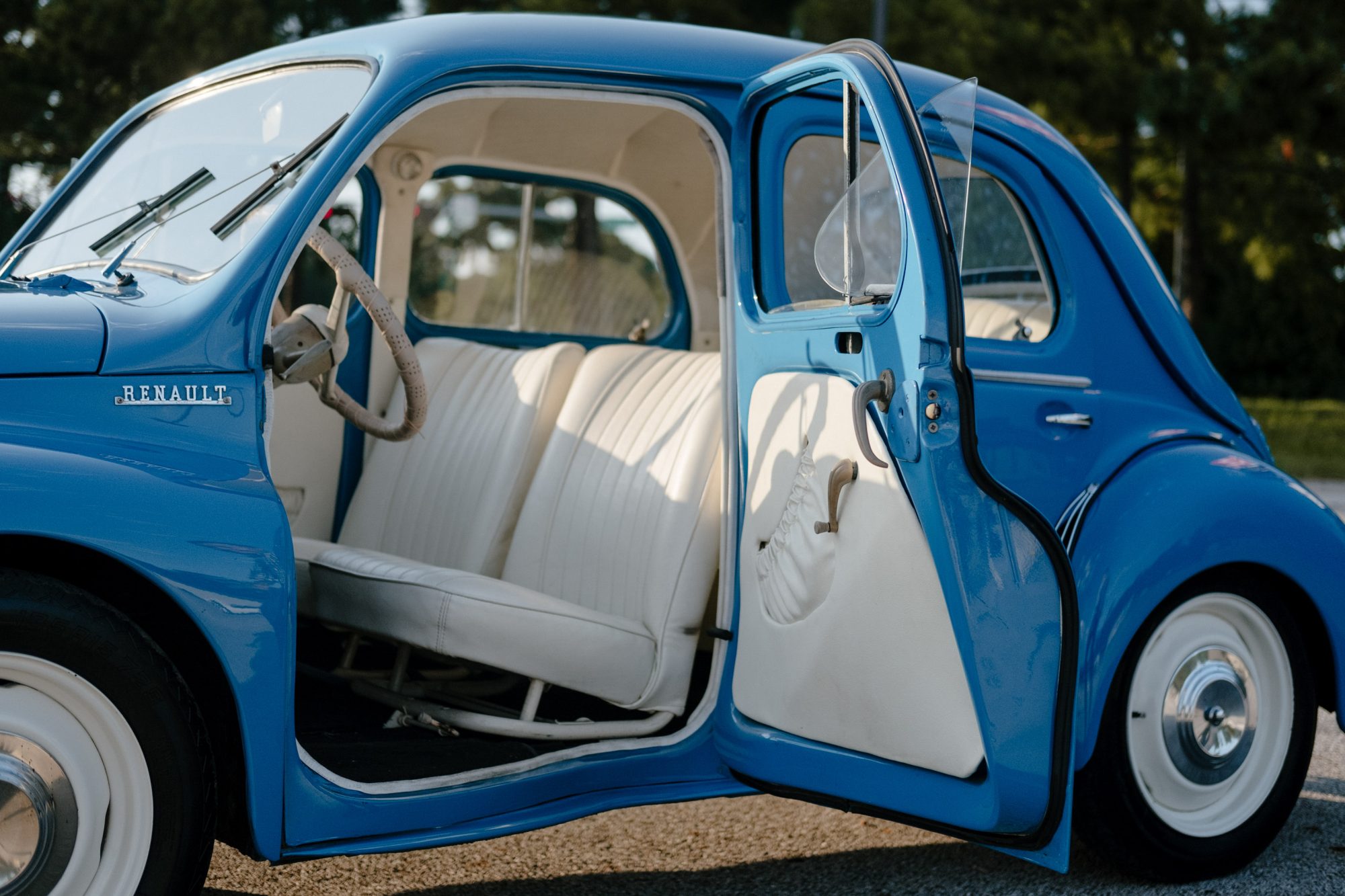
Photography by Dennis Nguyen, pre-restoration photos provided by Bill Fester
What decides the fate of objects? Two cars can leave the factory doors in sequential order, but check in on them a few decades down the road and one may be a preserved portal to the past while the other lies abandoned in a field to be slowly subsumed back into the earth. The paths diverged somewhere, but there are also those times when a car can live both of these lives. It is people after all who dictate these outcomes, and sometimes they decide that a car is worth saving from those who’ve decided it wasn’t. This bright blue 1958 Renault 4CV has lived a life that at one point seemed definitively over, but thanks to Bill Fester and a forklift, it was quite literally hauled out of its grave to be restored both in metal and dignity.
As the first French automobile to hit the million-units mark, as well as bearing many similarities to the Volkswagen Beetle (Ferdinand Porsche was consulted for the project and was later a war crimes prisoner in France during the car’s production, meaning at least the dots were there to connect), the Renault 4CV has an interesting history as a model, but let’s zoom in on just one particular example. The car seen here has since been sold to a friend, but Bill Fester was the owner responsible for reanimating it.
Alex Sobran: How did you become interested in the 4CV as a model; why were you looking for one?
Bill Fester: My Dad always had small foreign cars when I was growing up, and I suppose I inherited some genes from him or was influenced in some other way, because by the time I found the Renault I’d acquired a BMW Isetta, an older Mini, and a Fiat Multipla. And given the nationalities of my collection, I figured it was about time I found something French.
AS: I suppose that means a Kei car could be in your future! Where did you find this 4CV once you decided to start looking?
BF: This one just appeared on eBay one day, and the photos presented it as a much nicer car than it really was, as is so often the case. To be honest I’d never seen one in person before—though many were produced, there were never a lot of them in the US—but my dad said they were really nice little cars, so I was intrigued. I figured that despite the rough shape it was in, though I wouldn’t know how bad it really was until later on, it could be restored and brought back to roadworthiness. It was an inexpensive car to begin with, so what could it cost to restore? That turned out to be an enormous financial miscalculation!
AS: You said it was a bit rougher than the ad would have had you believe; what state did you find the car in when you first saw it in person?
BF: Well before I saw it I’d called the owner—a scrap yard, first hint—during the auction and asked if this was a project car or a parts car. “Oh,” they said, “it won’t be too bad to fix up and get on the road.” Buoyed by this not at all flippant assessment of the car’s condition, I rented a trailer and turned the trip to Missouri into a long family weekend.
We arrived to find a car in a field that looked like it was half subsumed already. Flowers and grasses and other reedy things were growing up through the floor. “It won’t be too bad to fix up and get on the road,” was echoing in my head and getting louder each time…
There have been times when I considered the error of judgment I made by not simply leaving it there to live the rest of its days as a flower pot, especially when I think back to the process of removing it from the plot of land on which it was resting on and turning into; it was loaded on my trailer with a front end loader (which did it no harm despite the rust-weakened frame), and we towed it back to Houston. I suspect we lost decades of dirt and debris during that return trip, as every jounce of the trailer shook loose evidence of its past life. I am sorry if you were following me that day! I suppose I might owe you a car wash if so.
Anyway, I would say that it was like most of the vehicles I’ve ever owned, the Renault followed me home, literally and figuratively this time.
AS: What was the restoration process like? Given this car’s rarity in the United States, how did you go about more or less rebuilding something with so few resources available here? Are there any distinct memories that’ve stuck with you from this learning process?
BF: I’d only ever been through one large restoration project before, and that was a simpler vehicle, and one in which parts were easier to come by. There are no resources here in Houston at all for Renaults whatsoever (I had a LeCar in the ‘80s, and there wasn’t much around for them at the time, and they were new cars then!), so most things came from a guy on the west coast who focuses on rear-engine Renaults. He had most of the mechanical items in stock thankfully. I didn’t try to translate my way into overseas vendors, and so I figured this was the most efficient way to get what I needed.
There wasn’t a panel on the whole body that didn’t have some sort of rust problem, including the roof. Some previous owner had had a minor front end collision at some point in the past too. Naturally there were some trim pieces missing. As far as the mechanicals, the cylinders were full of mud daubers and the motor was completely seized up. Since these are wet sleeved engines, that wasn’t the end of the world though, as I had new sleeves and pistons put in. That gave me the option of having a numbers-matching car, but the new internals utilizing later Dauphine components make it an 850cc versus the 750cc it was originally.
The body/chassis was at the body shop for over a year. They did a remarkable job, and at some point I had to decide on a color for it. The original was some sort of black with a vague dark gray two-tone scheme. I’d seen a photo somewhere online of a blue one, though I didn’t research it completely to see what year, what shade of blue it was, so I thought about it and decided that I would get it to what I thought was sort of a French Blue color. The original wheels were a shade of whitish silver, and I chose a new color as close to French Vanilla as I could find. I’ve never regretted that choice, even if Renault didn’t paint them that way. I didn’t want the car looking like it took itself too seriously.
I had the drivetrain and chassis put back together by a shop I knew, and while good mechanics, they weren’t exactly able to follow a full shop manual for everything. The beauty of this car though is its simplicity. It’s not like you need a ODBII scanner to realize there’s no fuel, or no spark. In most cases you can just reason through it and do the necessary fixes and it will be fine.
AS: After the car was complete, what did you do to enjoy it in its second life? And of course, we all want to know what it’s like to drive a rear-engined, rear-wheel drive Renault! How does the car handle? What is it like to live with?
BF: I’m thinking that for most restorations, at least those on unusual cars, there’s a learning curve to figuring out what the engineers were thinking when they designed them. Then there’s an unwinding process of determining what was done to the car during its lifetime. Both of those things can be mysterious. Then there’s the extent of the actual restoration. In any case, it’s a story. Sure, it’s not something that can be written per se, but in every make, and in every vehicle, there is an unfolding story that’s added to every instant of its existence. For this car I’m sure its life wasn’t always as sad as the period in which I found it, and though most of it is a mystery, I have at least given it a chance to add a new chapter.
In this case, I got the car back together but didn’t drive it much since most all restorations require a period of “getting the bugs out.” And because I have other machines and projects, I just never drove it all that much. I had additional brake problems (they used copper lines on this car, and bonded lining that came unbonded), fuel troubles, electrical gremlins (mostly grounding issues), and so forth. That’s probably the norm though and while I’ve learned the adage “If it’s French, you’ll need a wrench,” I don’t know that it’s any less reliable than any other almost-60-year-old car.
I did drive it a bit though, and early on I’d pumped the tires up to what I considered normal for an old car with skinny wheels. It handled so awfully though that I was genuinely amazed thinking of the people who had raced these things in early SCCA events. Thinking there must be something I was missing, I got hold of a guy who had one and he asked what pressures he was using. When I told him mine, he explained that the front tires should be at 17psi and the rear at 21psi. Also, given the rear bias, I put a bit of weight in the front storage area to balance it. Then it handled like any other rear-engined car, which is to say it was a bundle of fun! It’s always had quirks like an auto-choke that doesn’t operate well in cold weather, a non-syncro’d first gear—which in a three-speed means you aren’t going to walk any stop signs as 2nd gear is too tall to start out in—and of course those suicide doors, which can make entrance and exit easier for sure, but you need to make sure they’re completely closed when you set out!
The 4CV is probably not a car you would consider taking cross country. I haven’t had mine on the freeway since it tops out at a speed a good bit slower than the traffic moves. I’ve driven it mostly in town, and it naturally gets attention at every stop sign, red light, parking lot, etc. There’s countless thumbs up and phone/ camera shots. I suspect that if cars have souls, then the little blue car that came back from the grave has to be pretty happy for its second chance!
AS: I’d asked already about memories from the project phase of its life, but are there any other experiences that stick out from the time you owned this car?
BF: About a year and a half ago, I met a guy with a 2CV who had started a French car club here. He knew the French Consul in Houston, and so we were invited to a couple of events which of course was good fun! And that’s where the stories come out, since people will come up and start telling you about their memories of being in a similar car as a younger person, etc. It’s like a novel that spins off with other small short stories involved. Just having people appreciate the car and be willing to share their knowledge of it and experiences with it has been the best part of owning it. It’s funny how a car seemingly so obscure nowadays can still be relevant to some people. That’s my favorite aspect of it, the people that it brings together.
AS: Stepping back to the 4CV model in general to finish, what do you think makes this car important? Why should people care about this Renault?
BF: Perhaps collectively we don’t think of cars in the same ways we did 50, 60, 70 years ago. For one thing, they’re not quite as dear as they were then (no one seems to be as attached to their cars as they once were), and for another, they don’t have form the same kinds of congregations around certain cars in the same way it used to be, which was a kind of tribal recognition when Ford guys wouldn’t be caught dead in a Chevy. That still happens, but at least as far as my experience goes, it’s not as fierce. Back then though foreign car owners were always seen as a different lot. Some of those brands became mainstream, like VW and Mercedes and BMW, but others may have barely had a presence before being taken away from the US market. Rare does not make things good on its own of course, but rarity combined with time certainly makes things seem more cherished, and we are more likely to forgive their flaws in hindsight.
Renault never had much of a dealership network until it was connected with AMC, which itself became part of Chrysler. Yet, while unseen here, they were the Toyota/Ford/ Morris Mini of France, and given what ultimately became of the company (which now operates Nissan and Mitsubishi), the humble 4CV is a bit like the Isetta, a vehicle that helped people through post-WW2 Europe but which most Americans simply view as “strange.” A few 4CVs came here for people who wanted something different, and as Americans I think our national DNA is in part made up of wanting something different. They wound up being repaired mostly by people who weren’t sure, but applied their natural mechanical skills to keep them on the road.
Still, these were built to be cheap and dependable cars with a limited life. We might idolize the Isetta as a weird and whimsical oddity now, but it was at best a simple machine intended to last until you could buy something better when it was conceived. The Renault 4CV and the Citroen 2CV were probably engineered in that same way, with the same goals.
Owning this in comparison to the other cars I’ve had has reinforced the revelation that at one time, the engineering and fabrication of cars in one country could be so different than in another. That’s why perhaps this is an important car, it is a piece of the past, and of a past that we as Americans never experienced. Our post-war boom was not a universality, and cars like this one provide a window into how others approached the practical aspects of automobile manufacturing in the face of very different circumstances than we’ve faced.
I think that’s one of the biggest lessons here; to understand that many different methods can reach the same end; an automobile. The product serves the same purpose as any car in a general sense of transportation, but the societies that produce them all have their own reasons and ways of doing so. And working on it, while the bolts and nuts are metric, as they would be on most any foreign car of that era, it’s being mindful of, and celebrating, this diversity of thought that’s important.




































